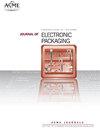A Transient Resistance/Capacitance Network-Based Model for Heat Spreading in Substrate Stacks Having Multiple Anisotropic Layers
IF 2.3
4区 工程技术
Q3 ENGINEERING, ELECTRICAL & ELECTRONIC
引用次数: 0
Abstract
Heat spreading from local, time-dependent heat sources in electronic packages results in the propagation of temperature non-uniformities through the stack of material layers attached to the chip. Available models either predict the chip temperatures only in the steady-state. We develop a transient resistance/capacitance network-based modeling approach capable of predicting the spatiotemporal temperature fields for this chip-on-stack geometry, accounting for in-plane heat spreading, through-plane heat conduction, and the effective convection resistance boundary conditions. The estimates from the present model are validated with direct comparison to a finite-volume numerical model for three-dimensional heat conduction. In the presence of a step heat input, the results demonstrate that the model accurately captures the transient temperature rise across the multi-substrate stack comprising layers with different anisotropic properties. For a case where the rectangular stack is exposed to a sinusoidally varying heat input the model is able to capture the general trends in the transient temperature fields in the plane where the heat source is applied to the multi-substrate stack. In summary, the developed resistance/capacitance network-based transient model offers a low-computational-cost method to predict the spatiotemporal temperature distribution over an arbitrary transient heat source interfacing a multi-layer stack of substrates.基于瞬态电阻/电容网络的多层各向异性衬底堆热扩散模型
来自电子封装中与时间相关的局部热源的热量传播导致温度不均匀性通过附着在芯片上的材料层堆叠传播。可用的模型要么仅在稳态下预测芯片温度。我们开发了一种基于瞬态电阻/电容网络的建模方法,能够预测这种叠层上芯片几何形状的时空温度场,考虑平面内热扩散、通过平面热传导和有效对流-电阻边界条件。通过与三维热传导的有限体积数值模型的直接比较,验证了本模型的估计值。在存在阶跃热输入的情况下,结果表明,该模型准确地捕捉了包括具有不同各向异性性质的层的多衬底堆叠的瞬态温升。对于矩形堆叠暴露于正弦变化的热输入的情况,该模型能够捕捉热源施加到多衬底堆叠的平面中的瞬态温度场的一般趋势。总之,所开发的基于电阻/电容的瞬态模型提供了一种低计算成本的方法来预测与多层衬底堆叠对接的任意瞬态热源上的时空温度分布。
本文章由计算机程序翻译,如有差异,请以英文原文为准。
求助全文
约1分钟内获得全文
求助全文
来源期刊

Journal of Electronic Packaging
工程技术-工程:电子与电气
CiteScore
4.90
自引率
6.20%
发文量
44
审稿时长
3 months
期刊介绍:
The Journal of Electronic Packaging publishes papers that use experimental and theoretical (analytical and computer-aided) methods, approaches, and techniques to address and solve various mechanical, materials, and reliability problems encountered in the analysis, design, manufacturing, testing, and operation of electronic and photonics components, devices, and systems.
Scope: Microsystems packaging; Systems integration; Flexible electronics; Materials with nano structures and in general small scale systems.
 求助内容:
求助内容: 应助结果提醒方式:
应助结果提醒方式:


